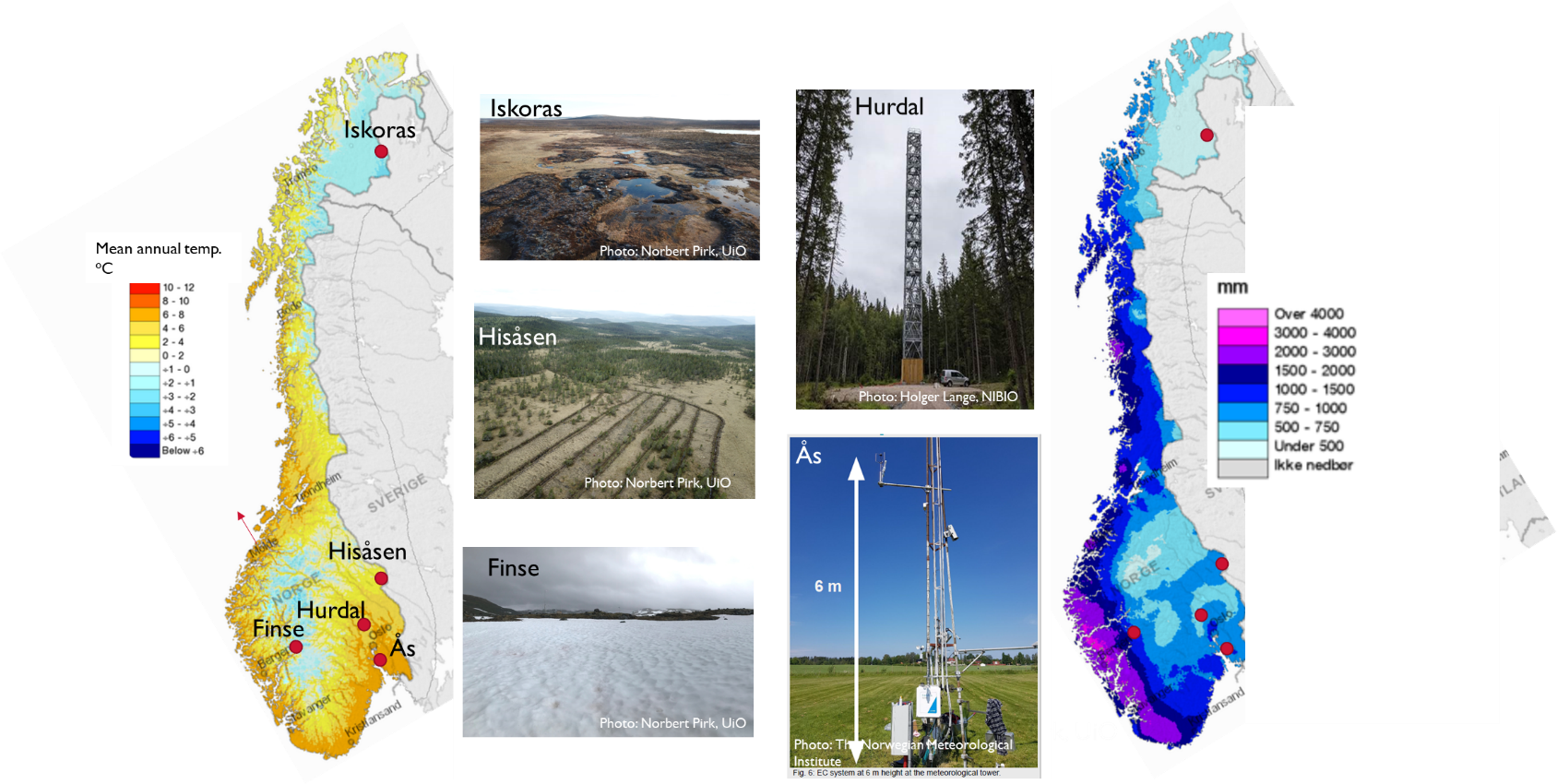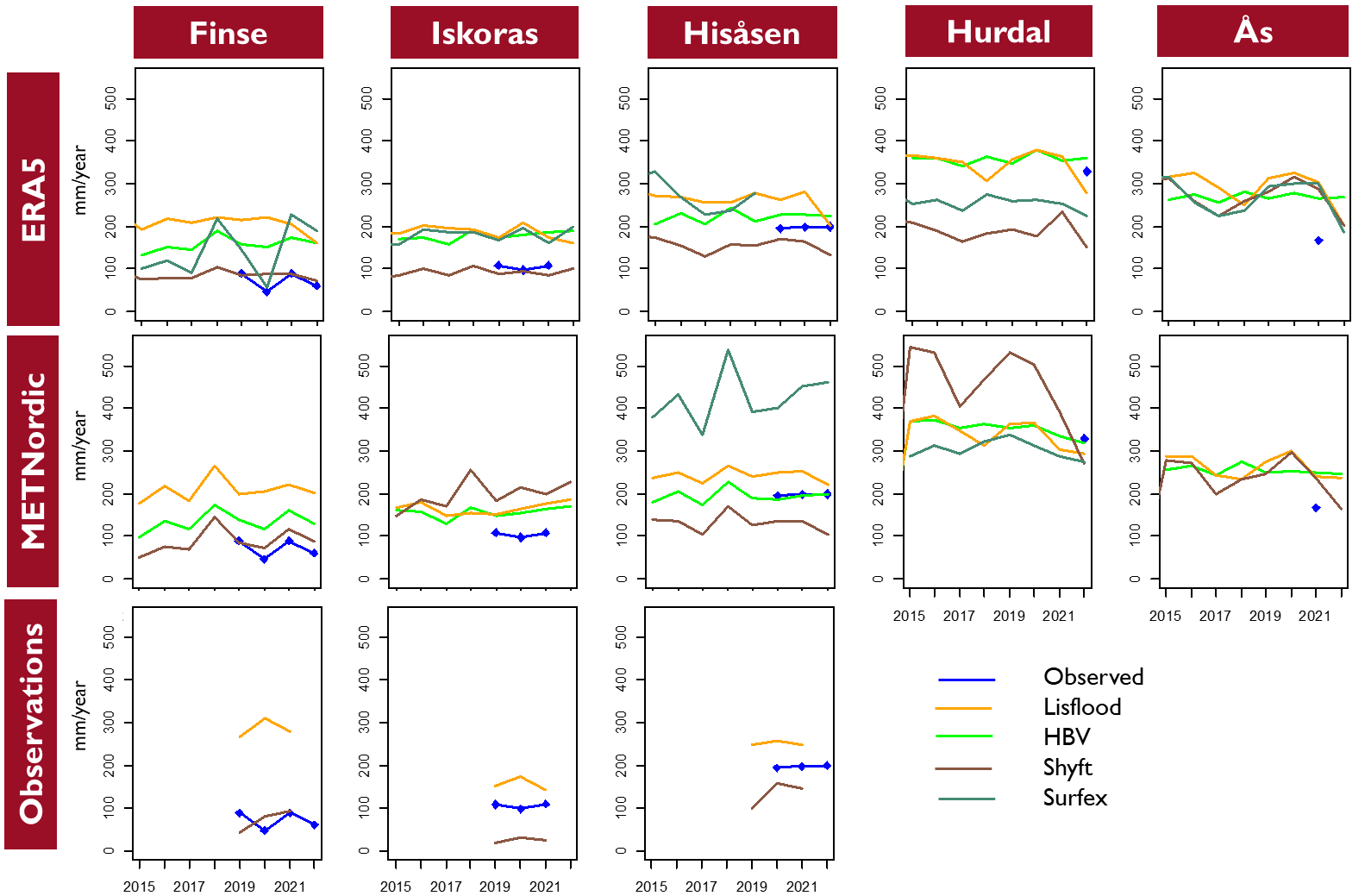Background and aims
The main motivation for LATICE MIP evapotranspiration is the need to improve knowledge about the actual evapotranspiration in cold environments. Recent estimates of mean annual evapotranspiration for Norway summarized in Erlandsen et al (2021) range from 175 – 500 mm/year, i.e. between 13 and 31% of mean annual precipitation (see Table 1). These estimates are based on different gridded versions of the hydrological, water balance model HBV, where the estimated evapotranspiration depends on precipitation inputs and streamflow measurements included in the model calibration. No reference measurements of evapotranspiration are used to benchmark the model estimates.
|
Source |
Period |
P (mm/y) |
E (mm/y) |
R (mm/y) |
|
HBV-E20 Erlandsen et al. (2021) |
1980-2014 |
1367 |
178 |
1179 |
|
HBV-H19 Huang et al. (2019) |
1983-2012 |
1333 |
221 |
1112 |
|
HBV-B03 Hanssen-Bauer et al. (2017) |
1971-2000 |
1600 |
500 |
1100 |
|
HBV-B03 Hanssen-Bauer et al. (2009) |
1961-1990 |
1486 |
346 |
1140 |
The aim of this MIP is to improve model estimates of evapotranspiration and thereby constrain the range of previous estimates of mean annual evapotranspiration by (i) introducing local observations of evapotranspiration and (ii) compare model estimates from two land surface models (CLM and SURFEX) and three hydrological models (HBV, Lisflood, and Shyft). Model estimates will be compared at three scales, namely point, catchment, and regional.
Evapotranspiration at the point scale
We are currently focusing on the point scale. At this scale, field observations of evapotranspiration are available at five eddy covariance flux sites covering a gradient in climate across Norway, from low altitude forested and grassland sites to high mountain and high latitude sites
The main reference sites for this MIP will be Finse, Iskoras, Hisåsen, Hurdal and Ås (Figure 1) . Finse, Iskoras and Hurdal are maintained by the LATICE group at UiO. NIBIO is operating the HURDAL station that also is a part of the ICOS network. The station at Ås is maintained by the Norwegian meteorological institute. The sites cover typical land covers in Norway including short cut grass, coniferous forest, grass covered mires and high altitude / latitude environments with low vegetation consisting of grass and shrubs. Ås and Hurdal have the highest mean annual temperatures, Iskoras the lowest. Iskoras is at the driest location whereas Fines has the highest mean annual precipitation. The wettest regions in Norway have not yet EC measurements. Table 2 lists the availability of EC evapotranspiration flux measurements at these sites. All data are available as 30 minute averages and are gap-filled.

|
Name |
Period with data |
|
Finse (UiO) |
01.01.2019 – 31.12.2022 |
|
Hisåsen (UiO) |
01.01.2019 – 31.12.2022 |
|
Iskoras (UiO) |
01.01.2019 – 31.12.2022 |
|
Hurdal (NIBIO) |
01.01.2022 – 31.12.2022 |
|
Ås (Met Norway) |
02.05.2022 – 04.11.2022 |
The following forcing datasets are extracted for the five sites:
- ERA5 reanalysis dataset of (Hersbach et al., 2013) available at the Copernicus climate data store, hourly surface levels was extracted for the period 1959 to 2021.
- ERA5 + TopoSCALE where Toposcale (Fiddes and Gruper, 2014) is a downscaling approach that uses a high-resolution digital elevation model to downscale coarse-grid climate variables, thereby providing provide high resolution forcing data for hydrolocical- and land-surface models.
- MET Nordic Analysis is produced on a grid with 1 km grid spacing and provided by the Norwegian meteorological institute. The products integrate output from MetCoOp Ensemble Prediction System (MEPS) as well as measurements from professional stations, citizen stations, and radar. MET Nordic analysis is available the thredds server at MET.
- Local gap-filled observations.
At these sites we will compare (i) the models’ ability to capture diurnal and seasonal variations in evapotranspiration and compare to the observations, (ii) how models simulate the relationship between potential and actual evapotranspiration, evapotranspiration fractions (transpiration, soil evaporation, and canopy evaporation) as well as the different components of the energy and water balance and (iii) the models’ sensitivity to forcing data will be assessed by using four different forcing data sets. Figure 2 demonstrates a first comparison of simulated and observed annual evapotranspiration at the five sites.

Contact person: Kolbjørn Engeland (kolbjorn.engeland@geo.uio.no, koe@nve.no)
References
Engeland, K., Erlandsen, H. B., Gelati, E., Huang, S., Narayanappa, D., Pirk, N., Silantyeva, O., Tallaksen, L. M., Vatne, A., and Yilmaz, Y. A.: Intercomparison of local evapotranspiration estimates at high latitudes, EGU General Assembly 2023, Vienna, Austria, 24–28 Apr 2023, EGU23-10854, https://doi.org/10.5194/egusphere-egu23-10854, 2023.
Erlandsen, H.B., Beldring, S., Eisner, S., Hisdal, H., Huang, S., Tallaksen, L.M.; (2021) Constraining the HBV model for robust water balance assessments in a cold climate. Hydrology Research; nh2021132. https://doi.org/10.2166/nh.2021.132.
Fiddes, J. and Gruber, S. (2014) TopoSCALE v.1.0: downscaling gridded climate data in complex terrain, Geosci. Model Dev., 7, 387–405, https://doi.org/10.5194/gmd-7-387-2014.
Hersbach, H., Bell, B., Berrisford, P., Biavati, G., Horányi, A., Muñoz Sabater, J., Nicolas, J., Peubey, C., Radu, R., Rozum, I., Schepers, D., Simmons, A., Soci, C., Dee, D., Thépaut, J-N. (2018) ERA5 hourly data on single levels from 1979 to present. Copernicus Climate Change Service (C3S) Climate Data Store (CDS). (Accessed on 29-06-2021). https://doi.org/10.24381/cds.adbb2d47.